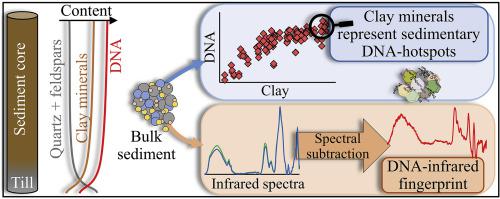当前位置:
X-MOL 学术
›
Appl. Geochem.
›
论文详情
Our official English website, www.x-mol.net, welcomes your
feedback! (Note: you will need to create a separate account there.)
Geochemical identification of potential DNA-hotspots and DNA-infrared fingerprints in lake sediments
Applied Geochemistry ( IF 3.1 ) Pub Date : 2020-11-01 , DOI: 10.1016/j.apgeochem.2020.104728 Hussein Jaafar Kanbar , Fredrik Olajos , Göran Englund , Michael Holmboe
Applied Geochemistry ( IF 3.1 ) Pub Date : 2020-11-01 , DOI: 10.1016/j.apgeochem.2020.104728 Hussein Jaafar Kanbar , Fredrik Olajos , Göran Englund , Michael Holmboe

|
Abstract DNA preserved in sedimentary materials can be used to study past ecosystem changes, such as species' colonization and extinction. It is believed that minerals, especially clay minerals, enhance the preservation of DNA. However, the role of minerals, as well as organic matter, on DNA sorption in heterogeneous sediments is still not clear. In this study, we examined the effect of mineral and organic matter on DNA binding in lake sediments. Bulk and size-fractionated sediments (0–4, 4–16, 16–64, and >64 μm), having different mineral and organic composition, were used to test DNA sorption; similar experiments were also run after the removal of sedimentary organic matter. Additionally, diffuse reflectance infrared spectroscopy (DRIFT) was used to determine the chemical changes caused by DNA sorption and subsequently produce a DNA-infrared (IR) fingerprint. Clay minerals were the main minerals to sorb DNA in the different samples. Moreover, mica promoted DNA sorption in all size fractions, while chlorite promoted DNA sorption in size fractions greater than 16 μm; clay-mineral and organo-mineral complexes caused a preference of certain clay minerals over others. Sedimentary organic matter affected DNA sorption by covering as well as by amplifying potential DNA binding sites, yet DNA sorption did not change significantly. DNA sorption showed IR spectral modifications mainly at ~1640, 1416, and 1231 cm−1. Interestingly, the DNA-IR fingerprint in the heterogeneous sediments was evident by those peaks after spectral subtraction. Finally, we proposed a simple model, based on sediment geochemistry, that can be used to determine potential DNA-hotspots in sediments.
中文翻译:

湖泊沉积物中潜在DNA热点和DNA红外指纹的地球化学鉴定
摘要 沉积物中保存的 DNA 可用于研究过去的生态系统变化,如物种的殖民和灭绝。人们相信矿物质,尤其是粘土矿物质,可以增强 DNA 的保存。然而,矿物质以及有机物对异质沉积物中 DNA 吸附的作用仍不清楚。在这项研究中,我们研究了矿物质和有机物质对湖泊沉积物中 DNA 结合的影响。使用具有不同矿物和有机成分的大块和分级沉积物(0-4、4-16、16-64 和 >64 μm)来测试 DNA 吸附;在去除沉积有机物后也进行了类似的实验。此外,漫反射红外光谱 (DRIFT) 用于确定由 DNA 吸附引起的化学变化,并随后产生 DNA 红外 (IR) 指纹。粘土矿物是吸附不同样品中 DNA 的主要矿物。此外,云母促进了所有大小部分的 DNA 吸附,而亚氯酸盐促进了大于 16 μm 大小部分的 DNA 吸附;粘土矿物和有机矿物复合物导致对某些粘土矿物的偏爱。沉积有机物通过覆盖和放大潜在的 DNA 结合位点来影响 DNA 吸附,但 DNA 吸附没有显着变化。DNA 吸附显示主要在 ~1640、1416 和 1231 cm-1 处的 IR 光谱修改。有趣的是,通过光谱减法后的那些峰,异质沉积物中的 DNA-IR 指纹是显而易见的。
更新日期:2020-11-01
中文翻译:

湖泊沉积物中潜在DNA热点和DNA红外指纹的地球化学鉴定
摘要 沉积物中保存的 DNA 可用于研究过去的生态系统变化,如物种的殖民和灭绝。人们相信矿物质,尤其是粘土矿物质,可以增强 DNA 的保存。然而,矿物质以及有机物对异质沉积物中 DNA 吸附的作用仍不清楚。在这项研究中,我们研究了矿物质和有机物质对湖泊沉积物中 DNA 结合的影响。使用具有不同矿物和有机成分的大块和分级沉积物(0-4、4-16、16-64 和 >64 μm)来测试 DNA 吸附;在去除沉积有机物后也进行了类似的实验。此外,漫反射红外光谱 (DRIFT) 用于确定由 DNA 吸附引起的化学变化,并随后产生 DNA 红外 (IR) 指纹。粘土矿物是吸附不同样品中 DNA 的主要矿物。此外,云母促进了所有大小部分的 DNA 吸附,而亚氯酸盐促进了大于 16 μm 大小部分的 DNA 吸附;粘土矿物和有机矿物复合物导致对某些粘土矿物的偏爱。沉积有机物通过覆盖和放大潜在的 DNA 结合位点来影响 DNA 吸附,但 DNA 吸附没有显着变化。DNA 吸附显示主要在 ~1640、1416 和 1231 cm-1 处的 IR 光谱修改。有趣的是,通过光谱减法后的那些峰,异质沉积物中的 DNA-IR 指纹是显而易见的。











































 京公网安备 11010802027423号
京公网安备 11010802027423号